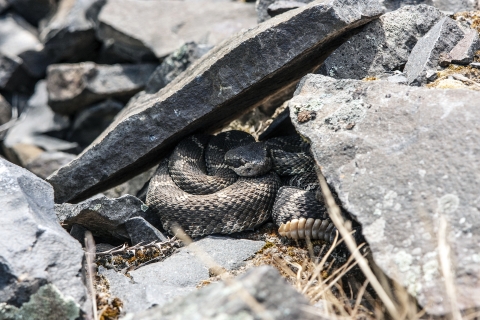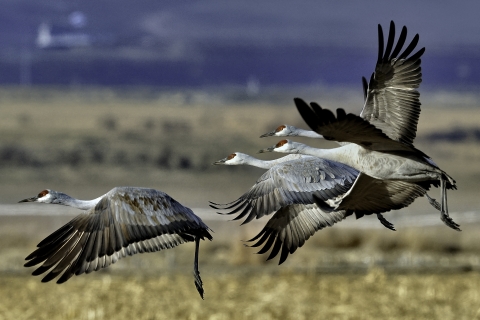Comprising nearly 30,000 acres, Columbia National Wildlife Refuge is a scenic mixture of rugged cliffs, canyons, lakes, grasslands and sagebrush. The combination of lakes and surrounding irrigated croplands, combined with generally mild winters and the protection provided by the refuge, attracts large numbers of migrating and wintering mallards, Canada geese, tundra swans and other waterfowl.
Visit Us
Columbia National Wildlife Refuge is a special blend of old and new, open and sanctuary, wildlife and landscapes. It's a wonderful place to visit in any season, at any time of the day, for any number of reasons.
Columbia is open to most uses seven days a week from sunrise to sunset. Some of the refuge is open year-round. Some is closed year-round. And some of the refuge is only open from March 1 to September 30 to provide sanctuary for wintering waterfowl. The primary canoe trail on Hutchinson and Shiner Lakes, and three of the four designated hiking trails, are only open during this time. One small section of the refuge is closed from February 1 to April for the protection of roosting Sandhill cranes. Call the refuge office at (509) 488-2668 to find out about seasonal closures.
The refuge office is located at 51 South Morgan Lake Road, approximately 3/4 of a mile north of the intersection of McManamon and Morgan Lake Roads. The office is open to the public, but there are no staff assigned to keeping the office open. When staff are in the office as part of their normal duties, the office is open from 8 a.m. to 5 p.m., excluding holidays. However, the staff is small, so when employees are in the field doing their jobs in managing the refuge, the office is closed.
Most areas of the refuge have no restroom or drinking water facilities. Refuge visitors should plan their trips accordingly. Please do not drink water from any lake or stream.
The refuge covers a variety of habitats including rough terrain, deep waters, dense stands of vegetation, stubble fields, and ditches. Access difficulty varies by area, and users should examine their own abilities and limitation before visiting the refuge. Contact the refuge office for suggestions on using the area safely.
The western rattlesnake is regularly encountered on the refuge and might be found anywhere during warm weather. They are most abundant in rocky areas. Visitors should be alert for them, but must remember that they, like all other species of wildlife on the refuge, are protected.
Location and Contact Information
About Us
It seems as if our world gets more stressful with each passing day. Columbia NWR offers a chance to unplug and reconnect with the world around us. With dozens of lakes, numerous trails, and abundant wildlife, visitors have a variety of activities available. The dramatic landscape is sure to spark an interest in the geologic forces that shaped the refuge, while the constant migration of birds makes the refuge a special place to view wildlife. Regardless of your interests, Columbia has something to offer.





